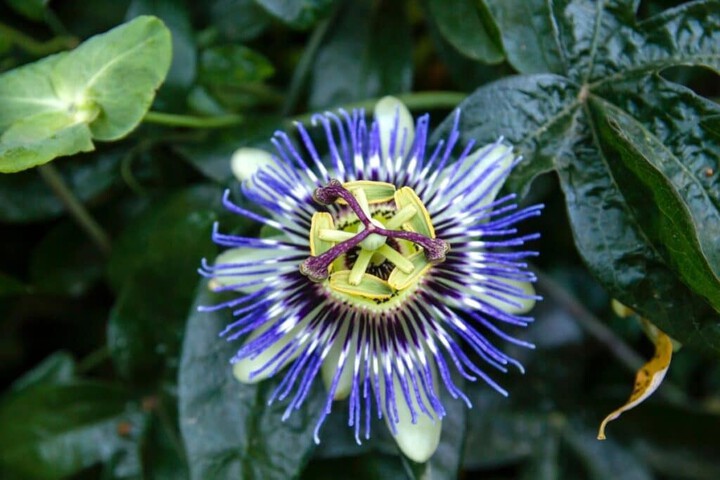When you think of the word ‘passion’, what comes to mind? Possibly some of the following definitions: a strong feeling or desire, love for something or someone, or maybe even the sufferings of Christ. Although some words may have varying meanings to different people, there are generally common themes. 
The passion flower may mean something different to some people, but it commonly symbolizes the crucifixion of Jesus. The flower itself has some features that have been related to different aspects of the crucifixion. Throughout the years, people have picked up on these similarities and have symbolized some of the different aspects of the flower.
What is a Passion Flower?
Let’s back up a little here, what is a passion flower? The passion flower is a vining perennial, meaning that it comes back year after year if taken care of properly.
The flowers are generally a purple color but can range from white to dark lavender. Some flowers will have alternating colors that appear as bands on the petals.
When the flowers bloom, there are 5 petals and 5 sepals (the outer parts of the flower that enclose the flower before it blooms). Above the petals form string-like segments that are usually a purple color and are called the corona filaments.v
The passion flower blooms from June to September. There are small yellow fruits that grow from the plant which are often referred to as “maypop” fruits.
These fruits can grow to the size of a chicken egg and if picked at the correct time, may taste like an apricot. These fruits are not commonly eaten, but the flavor extract is sometimes used in tea.
Symbolism of the Passion Flower
Now, back to the meaning of the name for the passion flower. As mentioned previously, the name “passion flower” is based on the crucifixion of Jesus.
You may wonder, what relevance does this flower have to crucifixion? The flower itself has some physical characteristics that supposedly symbolize different aspects of the crucifixion.
The Corona Filaments
These filaments grow in a ring right above the petals and sepals on the passion flower. These filaments are said to represent the crown of thorns that Jesus wore before his crucifixion. The word “corona” is actually defined as being like a crown, or in the shape of a crown.
Stigma
At the top of the flower, above the petals, sepals, and corona filaments, there are three stigmas. The stigma is the part of the flower that receives pollen and initiates fertilization. The three stigmas on the passion flower are said to represent the three nails that held Jesus to the cross.
Petals and Sepals
As mentioned before, the passion flower has five petals and five sepals. For the sake of symbolism, many refer to all ten of these pieces as petals. The ten “petals” are said to represent the ten apostles who were faithful to Jesus throughout the crucifixion.
Anthers
The passion flower has five anthers that can be found right below the three stigmas. The anthers are the parts of the flower where pollen is produced. The five anthers are said to symbolize five wounds that Jesus suffered when he was crucified.
Maypop Fruit
Although not found in all translations, the maypop fruit produced by the flower is often symbolized as well. For some, it represents our world that Jesus saved when he sacrificed himself. The fruit is generally a round shape, which is why it is referred to as the earth in this reference.
Uses for the Passion Flower
The passion flower isn’t just a pretty flower to grow in your garden, it has some medicinal properties as well. Although there is no formal scientific research to support its use, many use it for the following:
Anxiety
It is said that the chemicals found in the passion flower have calming properties. Ingesting these chemicals orally may reduce some of the symptoms of anxiety.
Insomnia
There are also claims that the chemical extract from the passion flower can be used to help someone with insomnia fall asleep.
Some add the extract to tea or other drinks before bed in hopes that they will be able to fall asleep easier than they would have otherwise.
Several decades ago, passion flower extract was formerly used in some over-the-counter sleep aid medications. However, in 1978, the FDA revoked its backing of the medication because there was not enough evidence for its safety or effectiveness.
Stress
The calming effects that the passion flower allegedly has is also used by some to reduce stress. The chemical extract from the flower is supposed to be taken orally, and supposedly can take effect within 30 minutes.
ADHD
There has been some research on the effects of passion flower extract in reducing the effects of ADHD in children. Sometimes used as an alternative to prescription medication, the passion flower is said to work similarly to low doses of methylphenidate. Again, not enough research has been done to formally back this method.
Flavoring
Passion flower extract is also used as a flavoring, most commonly in tea. It is said that passion flower, when used in tea, adds a mild grassy earthiness flavor that is usually supplemented with sugar or a sugar alternative. The passion flower fruit itself is said to have a sour taste, but can be mildly sweet if picked when perfectly ripe. The taste is sometimes compared to an apricot.
Origin of the Passionflower
The name “passion flower” was given to this plant in the sixteenth century. Christian missionaries in South America encountered the flower while on their journey and discovered that many of the flower’s physical features aligned with the crucifixion. Thus, the “Passion of the Christ” reference has stuck ever since.
The passion flower started to become widely known, and many used the flower to teach about the crucifixion. The flower naturally grows throughout South America and in Mexico, but can now be found all over the globe.
You Might Like ...